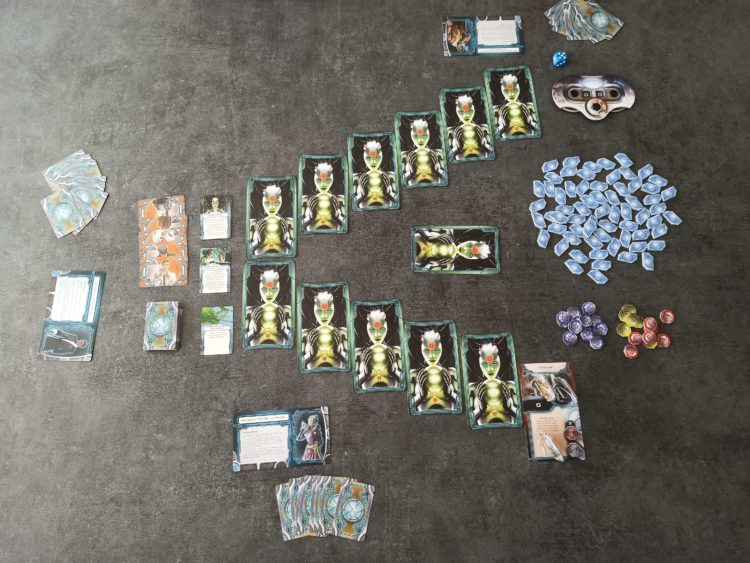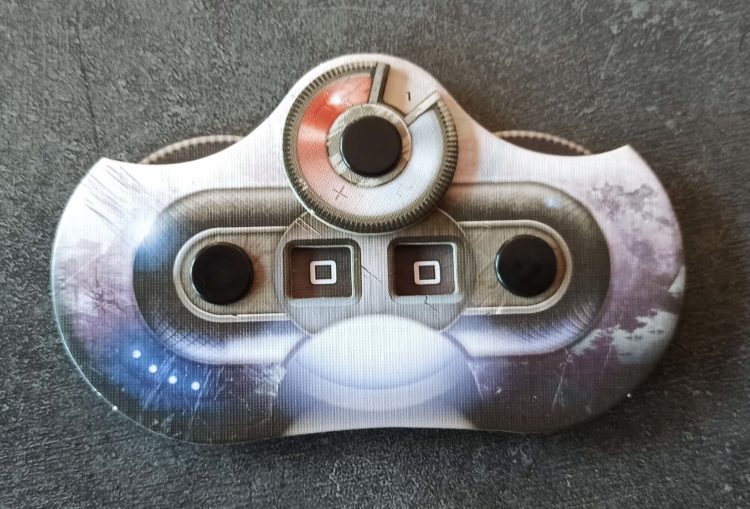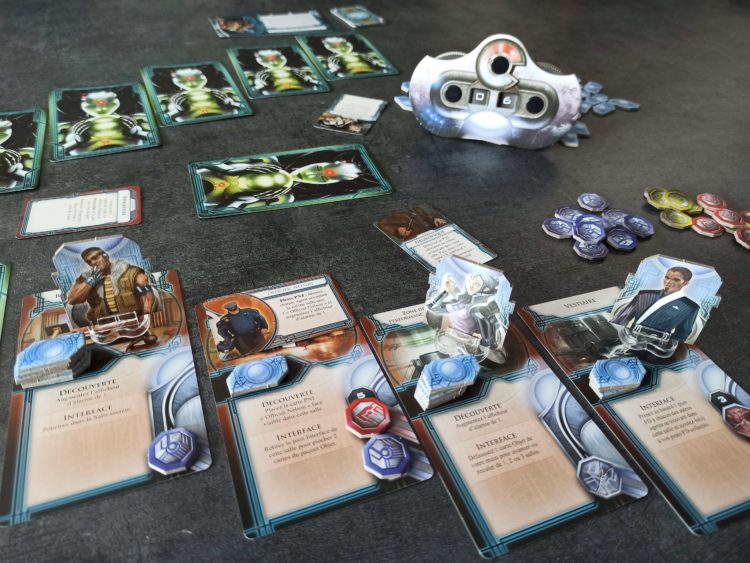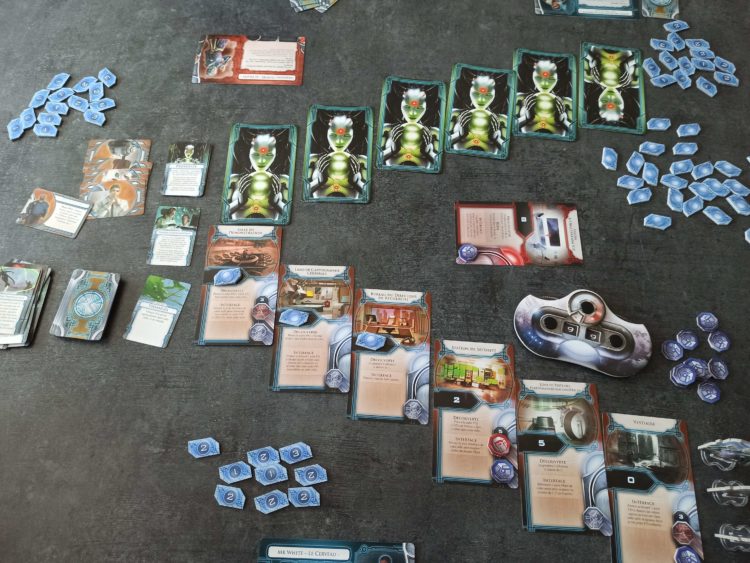
OBJECTIVE OF INFILTRATION: Steal more files than your opponents and get your agent out of the research center before the police arrives
NUMBER OF PLAYERS: 2-6 players
NUMBER OF CARDS:
- 32 Room cards
- 6 Agent cards
- 30 Action cards (6 of each action type)
- 35 Item cards
- 6 Special cards
- 5 NPC cards
- 6 Agent pawns and their base
- 117 File tokens
- 13 Scientist/Lock tokens
- 13 Interface tokens
- 1 Security monitor
- 1 six-sided die
TYPE OF GAME: Exploration, Action management, Stop or More
AUDIENCE: Teens, Adults
INTRODUCTION OF INFILTRATION
A powerful corporation has made a breakthrough in the Artificial Intelligence research and development. You have been hired along with other agents to infiltrate their research center and steal as much data as possible, or ideally one of their precious prototypes. But beware your “colleagues” who could decide to deal a low blow and have you captured while they escape before the police arrives.
Infiltration is a race against time set in the Android Netrunner cyberpunk universe. The more you spend time advancing through the successive rooms of the building, the higher your chances to find valuable files to steal, but also the higher your chances to run out of time to get out. A timer progresses each turn to indicate how far the police forces are from the building. Each agent still in the building when the police arrives will be captured and eliminated. Among the survivors, the one with the most files wins!
GAME SETUP
Shuffle the ground floor Room cards (blue light) and place six of them face down in a shifted line, then do the same with the first floor Room cards, placing them in a reverse shifted line so that the twelve Room cards form a V shape. Shuffle the Secret Room cards and draw one, place it face down in the center of the V shape.
Sort the Scientist/Lock and Interface tokens and place them on the table near the Rooms. Do the same with all the File tokens, but take care to all place them face down.
Place the NPC cards near the research center.
Deal to each player:
- one Agent card and the corresponding Agent pawn
- 4 Action cards (one of each type: Advance, Withdraw, Interface, Download)
- 4 Item cards at random (remaining Item cards form the draw pile)
Reveal the first ground floor Room card and place each player’s Agent pawn on it. If the revealed room has an Intrusion and/or Reveal effect(s), apply them now.
The first player is determined at random and takes the die and the Security monitor.

THE PLAY
The game is played in a succession of rounds, each round being composed of 4 phases:
- Selection phase
- Execution phase
- NPC phase
- Security phase
1. SELECTION PHASE
Each player looks at his cards hand, made of his Action cards and Item cards, and chooses one of them to play this turn.
Note that players being Delayed are not allowed to choose the Advance or Withdraw action card.
2. EXECUTION PHASE
Starting with the first player, each player executes the effect of the Action/Item card he had chosen.
Action cards
- Advance: move your agent one room further into the research center; if the room your agent enters has an Intrusion effect, resolve that effect immediately; if the room was not revealed yet, turn it face up and apply its Revealed effect if there is one
- Withdraw: move your agent one room back towards the entrance; if the room your agent enters has an Intrusion effect, resolve that effect immediately; if your agent was on the entrance room when you played this card, he escapes the research center
- Download: if you are the first player to play the Download action in the room where your agent is, your agent steals up to two of the File tokens available, otherwise he takes only one File token
- Interface: if you are on a room that has an Interface effect AND at least one Interface token, discard that token and apply the Interface effect
Item cards
Each item card has an effect described on it. If the effect of an Item card goes against the game rules, the card effect prevails. Some Item cards are to be played in the room where the agent is. Place the item card on the room card, it remains there as long as its effect description requires it.
3. NPC PHASE
NPC cards appear in a room when a room’s Revealed effect states so. Some NPC will appear face up while others appear face down, as per the NPC card description.
Going room by room, starting from the entrance room, the first player applies the effect of each NPC card that is present face up in a room (if two or more NPCs are in the same room, the first player chooses in which order to execute their effects).
When a player uses an effect to destroy an NPC, it doesn’t matter whether the NPC card is face up or face down, the NPC is destroyed anyway.
4. SECURITY PHASE
The Security monitor represents the progress of the police forces towards the research center. The first player rolls the die and adds its result to the value of the Alarm display, on the top of the Security monitor. That total is used to increase the Proximity display (lower part of the Security monitor). The left wheel is for the tens, the right wheel is for the units. If the Proximity display reaches 99, the game ends.

THE ROOMS OF THE RESEARCH CENTER
Here are the details of a room’s characteristics:
- Room type: the indicator light helps to recognize the room’s type; blue for ground floor, yellow for first floor rooms and red light for secret rooms
- File tokens: each room has a number of Files directly accessible to agents in the room; when a room is revealed, place the indicated number of tokens on the room card
- Intrusion effect: to be applied each time an agent enters the room
- Revealed effect: to be applied only once, when one of the agents enters the room for the first time
- Interface effect: this effect may be applied when performing the Interface action in the room, but only if there still is an Interface token in the room; the Interface action is performed either via the Interface action card or an Item card providing the Interface action, and most of the time it requires the player to remove the Interface token on the room and place it back in the reserve; once a room has no Interface token left, its Interface effect cannot be triggered anymore
- Lock effect: a Lock token in a room indicates that some precious information are protected; to trigger the Lock effect (and thus get access to these information) an agent has to destroy the Lock (usually with an Item card); when that happens, the agent removes the Lock token and places as many additional File tokens on the room as indicated above the Lock slot
- Scientist: in certain rooms there are scientists working on sensible subjects; when a Scientist is destroyed by an agent, remove the Scientist token and place the corresponding number of Files tokens on the room as indicated above the Scientist slot
- Advance effect: to be applied automatically when an agent performs the Advance action while being in the room
- Withdraw effect: to be applied automatically when an agent performs the Withdraw action while being in the room
REVEALING A ROOM
Perform the following steps when an agent enters in a room that is still face down:
- turn the room card face up
- resolve any Revealed effect present on the room card
- resolve any Intrusion effect present on the room card
- place Interface/Lock/Scientist tokens on the available slots of the room card
- take the number of File tokens indicated on the Files slot of the room card without looking at them and place them on the card
SECRET ROOM
The Secret Room contains highly valuable information, and may be accessed only through specific rooms, using the Advance action. In the same way, getting out of the Secret Room requires the Withdraw action and only leads to a Specific Room. Note that these entrance/exit rooms are not necessarily present in the research center depending on the Room cards drawn during the game setup, and even if they are, they have to be revealed to be used to enter/exit the Secret Room.
The Secret Room is not considered to be adjacent to any other room regarding the game effects that apply to adjacent rooms.
BEING DELAYED OR WOUNDED
When an agent is wounded by a game effect, such as the attack of an NPC or a card played by another player, the player turns his Agent card on the red side. As long as an agent is wounded, he cannot be wounded anymore. Moreover, when a wounded agent uses the Advance or Withdraw action, he is Delayed.
Being Delayed means that the agent will not be able to use neither the Advance nor the Withdraw action during his next turn.
Some Item cards allow the agent to be healed. When an agent is healed, turn the agent card on the blue side.

WINNING
The game ends immediately when one of the following events occurs:
- the Proximity display of the Security monitor reaches 99
- all the agents manage to escape the research center by performing the Withdraw action while being in the entrance room or by using any other game effect that allows them to escape
When the game ends, each player counts the total of Data Points displayed on the File tokens collected by his agent. If a player has managed to collect special cards that grant additional Data Points, that player adds those points to his/her total. The player with the highest total wins the game. In case of a tie, break it by comparing the following possessions, in decreasing priority order:
- Prototype card
- number of File tokens
- Compromising File card
Of course, any agent that did not manage to escape before the Proximity display reached 99 is eliminated and doesn’t count his total, unless he has the Compromising File card, which can be exchanged to get released by the police. If only one player managed to escape, that player wins.

VARIANTS
SHORTER/LONGER GAMES
You may start the game with the Alarm display value at -1 to have aslightly longer. On the contrary, set it to 1 instead of 0 to have a slightly shorter game.
EXTRACTING DATA
Instead of using the Download Action card, deal each player an Extract card during the game setup.
At the end of the Execution phase, each player having played the Extract action is able to take up to four File tokens in the room where he is, depending on the number of the total number of players in that room that played the Extract action:
- 1 player: 4 tokens
- 2 players: 2 tokens per player (if there are enough)
- 3 or more players: 1 token per player (if there are enough)
The tokens are taken by players following the turn order.
TWO PLAYER GAME
- Each player takes two agents instead of one.
- Maintain a clear separation between the cards, File tokens and other belongings of each agent, they are not allowed to exchange any game element.
- During his turn, a player may perform the action of his two agents in the order he wishes
- When the game ends, each player sums up the total of Data Points collected by his agents who managed to escape
- Comprehensive Guide to the Board Game Go (weiqi, baduk) - January 23, 2024
- Are Creative Suites Changing Gaming - October 30, 2023
- How Classic Games Have Been Reimagined for Modern Audiences - October 5, 2023